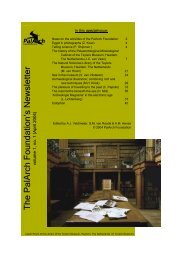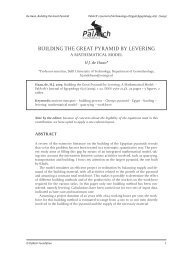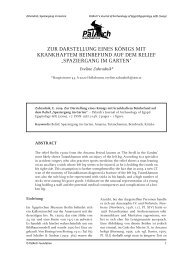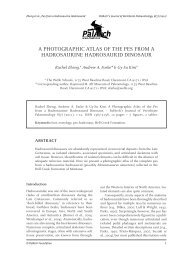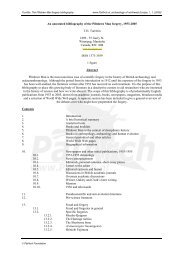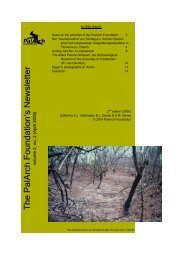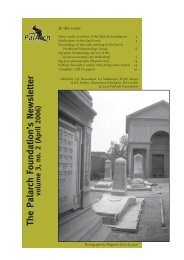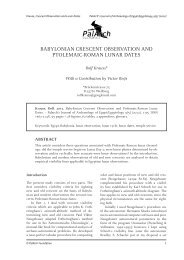PDF file (4.6 MB) - PalArch
PDF file (4.6 MB) - PalArch
PDF file (4.6 MB) - PalArch
You also want an ePaper? Increase the reach of your titles
YUMPU automatically turns print PDFs into web optimized ePapers that Google loves.
www.<strong>PalArch</strong>.nl Newsletter 5(2) (2008)<br />
In this issue:<br />
The <strong>PalArch</strong> Foundation’s Newsletter<br />
volume 5, no. 2 (July 2008)<br />
News on the Activities of the <strong>PalArch</strong> Foundation 2<br />
Vertebrate Palaeontology News 3<br />
News on the Archaeology of Northwest Europe 4<br />
Four-year IAE meeting Rhodes 4<br />
André J. Veldmeijer<br />
Journal of Ancient Egyptian Interconnections 6<br />
Richard H. Wilkinson<br />
Proceedings of the 11th meeting of the Dutch 7<br />
Vertebrate Palaeontology Group<br />
Natasja den Ouden<br />
Prof. Dr. S.K. Donovan awarded 8<br />
Megalith Memory Natasja den Ouden 9<br />
Egypt in Photographs Zbigniew Kosc 11<br />
<strong>PalArch</strong>: a new design Ilja Nieuwland 12<br />
Colophon / Call for papers 13<br />
Edited by I.J.J. Nieuwland, A.J. Veldmeijer, N. den Ouden,<br />
B.L. Beatty, E.N.A. Heirbaut, H.J.M. Meijer<br />
© 2008 <strong>PalArch</strong> Foundation (ISSN 1872-4582)<br />
an eteren oo orini as an slan r <strong>PalArch</strong>s rnal erterate Palaentl (2) (2008)<br />
HOMO FLORESIENSIS AS AN ISLAND FORM<br />
A.H. van Heteren<br />
School of Human and Life Sciences, Roehampton University, London, UK<br />
E-mail: a.vanheteren@roehampton.ac.uk<br />
<br />
Homo floresiensis as an island form. – Palarch’s Journal of Vertebrate<br />
Palaeontology (5)2 (2008), 1-19. ISSN 1567-2158. 12 pages 4 figures & 5 tables<br />
anthropology; Flores; Homo floresiensis; Indonesia<br />
<br />
Homo floresiensis is a small bodied hominin from the Indonesian island Flores. The type<br />
specimen, LB1, is believed to be a female of approximately 1 m or a bit more than 3 feet<br />
in length with a cranial capacity of around 400 cc. There is still no agreement on the<br />
cause of the small stature and small cranial capacity of LB1 and the associated individuals.<br />
Homo floresiensis displays several island adaptations, which also have been observed<br />
among the members of other typical island faunas, indicating that Homo floresiensis<br />
might very well have been an endemic island form. Homo floresiensis has morphology<br />
similar to that of a Homo erectus juvenile, since it has a high orbital, dental and brachial<br />
index, low humeral torsion, low tibial torsion and a high gonial angle. Additionally Homo<br />
floresiensis has shortened lower limbs. The features displayed by Homo floresiensis give<br />
an indication of the manner of dwarfing by paedomorphosis, which was by truncating<br />
growth through increase in the rate of skeletal ossification, possibly caused by hormonal<br />
changes.<br />
<br />
Homo floresiensis is a small bodied hominin<br />
from the Indonesian island Flores. The type<br />
specimen, LB1, is believed to be a female of approximately<br />
1 m in length with a cranial capacity<br />
of around 400 cc (Brown et al., 2004; Falk<br />
et al., 2005). There is still no agreement on the<br />
cause of the small stature and small cranial capacity<br />
of LB1 and the associated individuals. It<br />
is believed by some that Homo floresiensis is<br />
a descendant of Homo erectus or some other<br />
primitive hominin and derived the small stature<br />
and small cranial capacity by endemic island<br />
dwarfing (Brown et al., 2004; Morwood et al.,<br />
2005). Others believe that Homo floresiensis is<br />
a population of microcephales, or that LB1 is<br />
a microcephale from a population of pygmies<br />
(Richards, 2006; Jacob et al., 2006).<br />
That LB1 is a strange looking hominin from<br />
the island of Flores is agreed upon by the scientific<br />
community. However, whether his peculiarities<br />
are best described by island adaptations<br />
or pathology is currently the main focus<br />
of the scientific discussion.<br />
© <strong>PalArch</strong> Foundation 1<br />
Front page of the new layout of <strong>PalArch</strong> journals!<br />
© <strong>PalArch</strong> Foundation 1
www.<strong>PalArch</strong>.nl Newsletter 5(2) (2008)<br />
News on the activities of the <strong>PalArch</strong><br />
Foundation<br />
André J. Veldmeijer<br />
Congratulations! Unofficially, the Foundation and<br />
its journals exist for 5 years! However, the first issue<br />
appeared in 2005, so officially we have to wait<br />
one more year to celebrate. But since we are always<br />
in for a party, the managing editors and the<br />
board gather on July 4th. To be honoust, not only<br />
to toast the existence of the Foundation but also<br />
to discuss how we should proceed. Moreover, it<br />
would be good for all to see each other in person:<br />
silly as it may sound for such a small country as<br />
The Netherlands, some people have never seen<br />
each other despite collaborating for several years!<br />
The meeting will take place at the Foundation’s office<br />
and of course a report will be published in our<br />
January 2009 issue.<br />
We are proud that we can say that also our scientific<br />
publications are now also set in Adobe Indesign,<br />
which we think is an improvement. But of course, you<br />
can see for yourself: the first publication is online at<br />
http://www.palarch.nl/Palaeontology/palaeontology.htm.<br />
As announced previously (Newsletter Volume<br />
5, No. 1 [January 2008]), we will be able to sustain<br />
an online archive. The first publications will be<br />
put in our online archive on approximately August<br />
1st. Together with this, we offered our colleagues<br />
who published scientific papers to submit an erratum,<br />
which will be published in our January issue<br />
of the <strong>PalArch</strong> Foundation Newsletter.<br />
But there is more good news relating to durability<br />
and permanent access. We still work with<br />
the Royal Library in The Hague, The Netherlands<br />
in storing our publications. Unfortunately, unexpected<br />
events has lead to severe delays, but we<br />
are happy, however, to say that we are working to<br />
make a trial package of our publications for the<br />
Royal Library and we expect, safe unforeseen happenings,<br />
that all our publications will be delivered<br />
to the Library and hopefully are available online<br />
by January 1st.<br />
Fortunately, we have several submissions for<br />
our journals on palaeontology and archaeology of<br />
northwest Europe. Unfortunately, although we had<br />
four manuscripts submitted for our Journal on Archaeology<br />
of Egypt/Egyptology the last half year,<br />
three of them had to be rejected. One, however, is<br />
still in the review process and yet another one will<br />
be submitted within several weeks from now.<br />
Good news also about our e-book on scarabs by<br />
Cooney & Tyrrell (2005). At the IAE meeting (see<br />
further on in the Newsletter for a report), antiquarian<br />
Galerie Antinoë (Brest, France) expressed their<br />
interest and bought 20 e-books to sell at congresses,<br />
book fairs etc. We are happy of this of course<br />
and thank Carolien van Zoest for her help in establishing<br />
this contact.<br />
Finally, this: the figure text of Kosc photograph<br />
in our previous Newsletter was, as you might have<br />
noticed, wrong. The photograph is not of the mastaba<br />
of Mereruka, but of the wall of Djoser’s pyramid<br />
complex.<br />
Publications in the July Issue<br />
Papers in <strong>PalArch</strong>’s Journal of Archaeology of Egypt/<br />
Egyptology ISSN 1567-214X)<br />
Still online:<br />
Harbort, J. Ö. Gürvit, L.A. Beck & T. Pommerening.<br />
2008. Extraordinary dental findings in an<br />
Egyptian mummy skull by means of Computed<br />
Tomography. – <strong>PalArch</strong>’s Journal of Archaeology<br />
of Egypt/Egyptology 1, 1: 1-8.<br />
Book reviews in <strong>PalArch</strong>’s Journal of Archaeology of<br />
Egypt/Egyptology (ISSN 1567-214X)<br />
Clapham, A.J. 2008. Book review of: Cappers,<br />
R.T.J. 2006. Roman foodprints at Berenike.<br />
Archaeobotanical evidence of subsistence and<br />
trade in the Eastern Desert of Egypt. (Los Angeles,<br />
Cotsen Institute of Archaeology, University<br />
of California, Los Angeles [Berenike Reports 6,<br />
Monograph 55]). – <strong>PalArch</strong>’s Journal of Archaeology<br />
of Egypt/Egyptology 5(2): 1-4.<br />
Veldmeijer, A.J. 2008. Book review of: Parkinson,<br />
R. 2008. The painted tomb-chapel of Nebamun.<br />
Masterpieces of ancient Egyptian art in the British<br />
Museum (London, The British Museum).<br />
– <strong>PalArch</strong>’s Journal of Archaeology of Egypt/<br />
Egyptology 5(2): 4-5.<br />
Zoest, van, C.H. 2008. Book review of: Small, L.<br />
2006. Napolean on the Nile. Soldiers, Artists<br />
and the Rediscovery of Egypt (New York, Dahesh<br />
Museum of Art). – <strong>PalArch</strong>’s Journal of<br />
Archaeology of Egypt/Egyptology 5(2): 5-6.<br />
Papers in <strong>PalArch</strong>’s Journal of Vertebrate Palaeontology<br />
(ISSN 1567-2158)<br />
Heteren, van, A. 2008. Homo floresiensis as an island<br />
form. – <strong>PalArch</strong>’s Journal of Vertebrate Palaeontology<br />
5(2): 1-12.<br />
© <strong>PalArch</strong> Foundation 2
www.<strong>PalArch</strong>.nl Newsletter 5(2) (2008)<br />
Book reviews in <strong>PalArch</strong>’s Journal of Vertebrate Palaeontology<br />
(ISSN 1567-2158)<br />
Meijer, H.J.M. 2008. Book review of: Martill, D.M.,<br />
G. Bechly & R.F. Loveridge. 2007. The Crato<br />
fossil beds of Brazil (Cambridge, Cambridge<br />
University Press). – <strong>PalArch</strong>’s Journal of Vertebrate<br />
Palaeontology 5(2): 13-14.<br />
Veldmeijer, A.J. 2008. Book review of: Mol, D., W.<br />
van Logchem, K. van Hooijdonk & R. Bakker.<br />
2007. De sabeltandtijger uit de Noordzee.<br />
(Norg, Drukware). – <strong>PalArch</strong>’s Journal of Vertebrate<br />
Palaeontology 5(2): 14-16.<br />
Nieuwland, I.J.J. 2008. Book review of: Wellnhofer,<br />
P. 2008. Archaeopteryx. Der Urvogel<br />
von Solnhofen. (Munich, Friedrich Pfeil)/Bollen,<br />
L. 2008. Der Flug des Archaeopteryx. Auf<br />
der Suche nach dem Ursprung der Vogel. –<br />
<strong>PalArch</strong>’s Journal of Vertebrate Palaeontology<br />
5(2): 16-17.<br />
Papers in <strong>PalArch</strong>’s Journal of Archaeology of Northwest<br />
Europe (ISSN 1573-3939)<br />
Still online:<br />
Bringmans, P.M.M.A. 2008. First evidence of Neanderthal<br />
presence in Northwest Europe during<br />
the Late Saalian ‘Zeifen Interstadial’ (MIS<br />
6.01). – <strong>PalArch</strong>’s Journal of Archaeology of<br />
Northwest Europe 1, 1: 1-15.<br />
Stapert, D. 2008. Neanderthal children and their<br />
flints. – <strong>PalArch</strong>’s Journal of Archaeology of<br />
Northwest Europe 1, 2: 16-39.<br />
Warrimont, de, J.P.L.M.N. 2008. Prospecting Middle<br />
Palaeolithic open-air sites in the Dutch-Belgian<br />
border area near Maastricht. – <strong>PalArch</strong>’s<br />
Journal of Archaeology of Northwest Europe 1,<br />
3: 40-89.<br />
Turrittin, T.H. 2006. An annotated bibliography<br />
of the Piltdown Man forgery, 1953-2005. –<br />
<strong>PalArch</strong>’s Journal of Archaeology of Northwest<br />
Europe 1, 1: 1-50.<br />
Book reviews in <strong>PalArch</strong>’s Journal of Archaeology of<br />
Northwest Europe (ISSN 1573-3939)<br />
Enckevort, van, H. 2008. Book review of: Goodman,<br />
P.J. 2007. The Roman city and its periphery.<br />
From Rome to Gaul. (London/New York,<br />
Routledge). – <strong>PalArch</strong>’s Journal of archaeology<br />
of northwest Europe 3(2): 1-2.<br />
Vertebrate Palaeontology News<br />
Brian L. Beatty<br />
It has been some time since I wrote an editorial for<br />
our Newsletter, but I hope that I can bring some<br />
good news. First, after a bit of a slump in submissions<br />
rates last year our present rate of submissions<br />
has risen slightly, with seven papers submitted to<br />
<strong>PalArch</strong> since January 1st of this year! Delays in<br />
getting these out have stemmed largely from engaging<br />
in a more rigorous peer review in an effort<br />
to help make the papers all the better for it. Many<br />
of those have only come in during the last month,<br />
so I anticipate that the January 1, 2009 issue will<br />
be much larger, thanks to all of those that have<br />
submitted papers in recent months. We have some<br />
exciting work on taphonomy, fossil eggs, etcetera<br />
in the works, and I hope to see the submissions<br />
continue coming in.<br />
Regarding submissions, I would really like to<br />
see more reports of paleopathologies, new records<br />
of the geographic or temporal distribution of taxa,<br />
and more reviews. After some unexpected difficulty<br />
some colleagues of mine have had in publishing<br />
some small papers, I have seen firsthand<br />
how scarce such outlets are that are interested in<br />
publishing on the fossil record. Many journals like<br />
the Journal of Vertebrate Paleontology and others<br />
have such a tremendous backlog of papers already<br />
accepted that they have become more picky because<br />
of space concerns, and many papers of scientific<br />
merit that simply lack popularity are falling<br />
by the wayside, and perhaps forcing people to<br />
neglect publishing on fossils that don’t grab media<br />
attention.<br />
I was just in Tennessee for the first meeting of<br />
the Southeastern Association of Vertebrate Paleontology,<br />
held at the Gray Fossil Site (a rich late<br />
Miocene fauna), and got into a conversation with<br />
a good friend about this problem. We both noticed<br />
that fewer journals are interested in publishing papers<br />
that add small increments to the fossil record,<br />
even when this information could have profound<br />
effects on subsequent large-scale interpretations<br />
of paleoecology, paleobiogeography, systematics,<br />
evolution, and/or functional morphology.<br />
<strong>PalArch</strong> has no such space concerns thanks to<br />
the beauty of online publishing, and so though we<br />
maintain that peer review keep the work’s quality<br />
there, we are not interested in restricting ourselves<br />
to what may be interesting to the popular press or<br />
is beautiful and grandiose. I find it sad that journals<br />
that are not popular magazines like Nature<br />
and Science should be tending to become selective<br />
in similar ways to drive up impact factors. While<br />
© <strong>PalArch</strong> Foundation 3
www.<strong>PalArch</strong>.nl Newsletter 5(2) (2008)<br />
I wish that <strong>PalArch</strong> is valued for its impact, I hope<br />
that its impact is one that respects the value of<br />
new information for progress in our science, one<br />
that encourages us to share our individual knowledge<br />
with the collective world of science in a peerreviewed<br />
means instead of a popularity contest.<br />
So, if you have a new record of a taxon from a<br />
locality, or a review of a topic that you feel is worth<br />
addressing, please send it our way. This is for the<br />
science, not for our egos.<br />
Four-year IAE Meeting Rhodes<br />
André J. Veldmeijer<br />
News on the Archaeology of<br />
Northwest Europe<br />
Elly Heirbaut en Natasja den Ouden<br />
The dark gloomy months of winter have passed<br />
and we can now enjoy the first rays of summery<br />
sunshine. And we all know what that means, don’t<br />
we? Yes, we can zip off our trouser legs and pick<br />
up our trowels and shovels. It’s field season again.<br />
But before you all go off to play Indiana Jones,<br />
take a chance to read the two book reviews that we<br />
have for you. And why not print off this Newsletter?<br />
It will give you something to read when you<br />
are waiting for the all purpose mini van to take<br />
you from your campsite to the excavation.<br />
So have a good field season everyone, and we’ll see<br />
you again in winter.<br />
Every four years, the International Association of<br />
Egyptologists (http://www.iae.lmu.de/) meets during<br />
a 7 or 8 days congress. Four years ago it was<br />
in Grenoble, France; this year the “X International<br />
Congress of Egyptologists” was held 22-29 May at<br />
the Greek island of Rhodes. Rhodes is the third<br />
largest Greek island and, officially, the sunniest<br />
place in the Europe.” It is situated at the crossroads<br />
of two major sea routes of the Mediterranean between<br />
the Aegean Sea and the coast of the Middle<br />
East, as well as Cyprus and Egypt. Its capital<br />
city, located at its northern tip, is the capital of the<br />
Prefecture with the Medieval Town in its centre<br />
(which, in 1988 was designated as a World Heritage<br />
City). The Medieval Town of Rhodes is the result<br />
of different architectures belonging to various<br />
historic eras, predominantly those of the Knights<br />
of St. John.” (http://www.rhodes.gr/history/en/)<br />
The congress was held “at the Rodos Palace<br />
Hotel and Convention Center (Trianton Ave., Ixia,<br />
85100, Rhodes), one of the largest purpose-built<br />
conference centers in the Mediterranean region<br />
and the country’s most talked about and vibrant<br />
© <strong>PalArch</strong> Foundation 4
www.<strong>PalArch</strong>.nl Newsletter 5(2) (2008)<br />
meeting venue, with over 500 conferences and<br />
numerous exhibitions held in its premises and attended<br />
by Heads of State, Nobel laureates, innovative<br />
businessmen, renowned artists and scientists.<br />
With a total combined capacity of 4.000 delegates<br />
in 20 ergonomically designed multi-use halls ranging<br />
in size from 20-1300 persons the Center can<br />
support events of varying size and complexity.<br />
Having been selected as the official venue for the<br />
European union Summit and Western European<br />
Union Council of ministers, the Rodos Palace is<br />
identified as a prominent choice for rewarding<br />
conferences and incentives”<br />
Over 300 presentations were held during these<br />
6 days (the first day was reserved for registration,<br />
posting posters etc) and a boat trip to Lindos, combined<br />
with a visit of the Acropolis and the Temple<br />
of Athena after which there was time for swimming,<br />
was scheduled for the last day) and in total<br />
well over 500 scholars were registered. According<br />
to the congress’ website “The work of the Congress<br />
will be organized on a series of major themes<br />
within Egyptology, with a particular focus on<br />
multi-disciplinary approaches to general themes.<br />
Participants will be asked to orient their contributions<br />
towards one of the major themes, whatever<br />
the nature of the evidence and source material<br />
they are working with. The list of major themes<br />
for the Congress is yet to be decided but suggestions<br />
have included the following topics: Cultural<br />
Heritage, Egypt – Greece in Antiquity: ethnicity,<br />
cross-cultural interactions and adaptations, Archaeology<br />
and History of Art, The Egyptian beliefsystem:<br />
knowledge, sacred and profane, Sociology,<br />
Literature and Philology, The Archaic state and the<br />
origins of culture, History: historiography, foreign<br />
Relations and diplomacy.” They organizers warn,<br />
however that: “The list is not exclusive. The named<br />
themes are merely intended to provide a focus of<br />
discussion. Suggestions and comments from potential<br />
participants about themes to which they<br />
would like to contribute will be most welcome.”<br />
Be this as it may, the far majority of presentations<br />
were iconographic, art historical or Egyptological<br />
in nature. There were quite a few archaeological<br />
presentation but case studies of objects, let alone<br />
organic objects, were very few indeed. Not to mention<br />
topics of a more theoretical archaeological nature.<br />
Furthermore, the website reads “In addition<br />
to the papers read, special forums for work-groups<br />
will be considered” but there was only (if memory<br />
serves me well) one. Finally “facilities will be provided<br />
for poster sessions and visual displays. Participants<br />
should provide the Organising Committee<br />
with details of display area required and format of<br />
displays at the earliest possible date.” Unfortunately,<br />
posters are not really popular in Egyptology, in<br />
contrast to palaeontology, where it is a well established<br />
way of communicating research. Perhaps it<br />
is due to the fact that here, as well as four years<br />
ago, the posters were placed somewhat away from<br />
the main socializing area. The <strong>PalArch</strong> Foundation<br />
presented a poster as well as a A4 handout of the<br />
poster, which the organizers were kind enough to<br />
include in the information package each participant<br />
got, for which we like to thank them again!<br />
Please, visit http://www.rhodes.aegean.gr/tms/<br />
congress2008.htm for more information and the<br />
pdf of all abstracts of the presentations.<br />
© <strong>PalArch</strong> Foundation 5
www.<strong>PalArch</strong>.nl Newsletter 5(2) (2008)<br />
Journal of Ancient Egyptian<br />
Interconnections<br />
Richard H. Wilkinson<br />
The University of Arizona announces a new online<br />
journal to launch in late Fall 2008. The ‘Journal<br />
of Ancient Egyptian Interconnections’ will be<br />
a wholly online scholarly publication integrating<br />
Egyptian archaeology with Mediterranean, Near<br />
Eastern and African studies – providing a new<br />
venue for this growing field of interdisciplinary<br />
and inter-area research. The journal will publish<br />
full-length articles, short research notes, and reviews<br />
of published works, each of which will be<br />
peer-reviewed in a blind screening process by an<br />
Egyptologist and a specialist from the outside area<br />
of interaction.<br />
The journal will have a wider geographical and<br />
temporal range than existing publications while<br />
specializing in all aspects of interaction between<br />
ancient Egypt and its neighbors. The journal will<br />
consider potential contributions on any aspect<br />
of interaction (one- or two-way) between ancient<br />
Egypt and other cultures of the ancient world.<br />
Normally, the other cultures are those directly<br />
or closely surrounding Egypt in Africa, the Near<br />
East, and the Mediterranean world, though if interaction<br />
can be demonstrated between Egypt and<br />
more distant regions, that is acceptable. Posited<br />
interactions between Egypt and the New World<br />
will not be considered.<br />
The journal will be edited by Richard Wilkinson,<br />
Regents Professor of Egyptian Archaeology at<br />
the University of Arizona, and steered by an Executive<br />
Editorial Board composed of distinguished<br />
scholars from a number of countries around the<br />
world, including the following confirmed members:<br />
• Kathryn Bard, Professor, Boston University,<br />
USA<br />
• Daphna Ben Tor, Curator, The Israel Museum,<br />
Jerusalem, Israel<br />
• Manfred Bietak, Professor and Director, University<br />
of Vienna, Austria<br />
• Salima Ikram, Professor and Director, American<br />
University in Cairo, Egypt<br />
• Nanno Marinatos, University of Illinois, Chicago,<br />
USA<br />
• Donald Redford, Professor and Director, Pennsylvania<br />
State University, USA<br />
• Thomas Schneider, Professor and Editor, Journal<br />
of Egyptian History, Univ. of British Columbia,<br />
Canada<br />
• Günter Vittmann, Professor, University of<br />
Würzburg, Germany<br />
• Willemina Wendrich, Professor and Director,<br />
UCLA, USA<br />
• Nicolas Wyatt, Professor Emeritus, Edinburgh<br />
University, United Kingdom<br />
In addition, a core of distinguished specialists<br />
in various aspects and areas of Egyptian interaction<br />
will serve as editorial liaisons, working with<br />
the editor and reviewing submissions to the journal.<br />
A complete list of Editorial liaisons will appear<br />
on the journal website.<br />
An Editorial Production Board includes:<br />
• Dennis Forbes, ‘KMT: A Modern Journal of<br />
Ancient Egypt’, USA<br />
• Patricia Spencer, ‘Egyptian Archaeology’, Egypt<br />
Exploration Society, UK<br />
• André J. Veldmeijer, ‘<strong>PalArch</strong>’s Journal of Archaeology<br />
of Egypt/Egyptology’, Palarch Foundation,<br />
The Netherlands<br />
The ‘Journal of Ancient Egyptian Interconnections’<br />
will offer very rapid publication. If accepted<br />
for publication, submissions will normally appear<br />
within a very few months – or less – of receipt.<br />
Copyright of submitted material will remain with<br />
contributors so that submissions may be freely utilized<br />
by their authors in other venues at any time<br />
after their publication in JAEI.<br />
The inaugural issue of the ‘Journal of Ancient<br />
Egyptian Interconnections’ will be published in<br />
late fall 2008. Access and subscription information<br />
will be announced in October. The journal’s guide<br />
for contributors may be obtained from the editor<br />
at egypt@u.arizona.edu.<br />
© <strong>PalArch</strong> Foundation 6
www.<strong>PalArch</strong>.nl Newsletter 5(2) (2008)<br />
Proceedings of the 11th meeting of<br />
the Dutch Vertebrate Palaeontology<br />
Group held at Utrecht University, June<br />
20, 2008<br />
Natasja den Ouden<br />
There were 20 people present; Paul Albers, Jan Robert<br />
Brand, Hans Brinkerink, Jan van Dam, Francien<br />
Dielemans, Martha Koot, Hanneke Meijer, Albert<br />
van der Meulen, Dick Mol, Henk Oosterink, Natasja<br />
den Ouden, Marvin Overbeeke, Noud Peters, Femke<br />
Lindeman, Jelle Reumer, Charlie Schouwenburg,<br />
André Veldmeijer, Hannie de Visser, John de Vos and<br />
Wilma Wessels.<br />
Introduction<br />
Wilma Wessels welcomes us all at the faculty of<br />
Earth Sciences of Utrecht University. She notes that<br />
the past six months have been very productive, as<br />
the activities of a number of group members have<br />
made it into the news. Books have been published by<br />
Jelle Reumer, Dick Mol and John de Vos.<br />
Talks<br />
Femke Lindeman presents her research on the Pleistocene<br />
and Holocene seals of the North Sea. To be<br />
able to distinguish between species, she measured<br />
long bones and mandibles. The measurements, together<br />
with morphological characteristics, form<br />
the basis for species identification. She found that<br />
although the long bones of most species differ in<br />
size, the proportions are very similar. One exception<br />
is Phoca groenlandica. This species was present<br />
on the North Sea in the Pleistocene, although it was<br />
smaller than its modern counterparts. Many of the<br />
bones previously ascribed to P. vitulina are probably<br />
of P. groenlandica. Phoca vitulina was not present in<br />
the North sea until around 2000 BP. Apart from the<br />
mandible, the humerus proved to be the most diagnostic<br />
bone. From the discussion following the talk,<br />
it becomes clear that this is the case in other animal<br />
groups as well (e.g. marine reptiles).<br />
Paul Albers describes his quest for Saurosphargis<br />
voltzi. The first specimen was found in Poland<br />
around 1900. This species has very characteristic vertebrae<br />
with osteoderm spikes. In 1999 a concentration<br />
of bones was found in the Winterswijk quarry<br />
in the Netherlands. This concentration turned out<br />
to be very important, as not only vertebrae, but also<br />
other parts of the body were preserved. Even parts<br />
of the skull were found. The pre-orbital foramen of<br />
this skull shows some archosauromorph traits. As<br />
the skulls of this group fragment easily, it explains<br />
the general absence of them in the fossil record. The<br />
Winterswijk fossils contribute greatly to our knowledge<br />
of Saurosphargis. We now know that the animal<br />
was fully marine. Size differences of fossils between<br />
the two layers they were found in can be the result<br />
of taphonomic processes. However, they could also<br />
indicate the presence of two species, a larger and a<br />
smaller one.<br />
Hanneke Meijer has analysed the skull morphology<br />
of Tapejara wellnhoferi and compared it<br />
to modern birds, in order to infer feeding strategies.<br />
She especially wanted to test whether Tapejara<br />
could be a seed eater. In modern birds, skull<br />
morphology is linked with diet. In seed cracking<br />
birds, the angle of the quadratum with the ventral<br />
skull base is low. The angle of the quadratum with<br />
the ventral skull base in Tapejaridae falls within<br />
the range of modern-day probers. These are birds,<br />
such as waders and geese, that forage by probing a<br />
soft substrate for invertebrates. The Santana Formation,<br />
in which Tapejara was found, also yielded<br />
fossils of soft fleshy fruits, such as those of Brachyphyllum<br />
and Gnetalis. These fruits could well have<br />
been a food source for Tapejara. In concusion,<br />
Tapejara was not a nut cracker, but it ate fleshy<br />
fruits and probed the substrate for invertebrates.<br />
Henk Oosterink gives us a slideshow of the Winterswijk<br />
Quarry. This quarry consists mainly of<br />
Triassic sediments. At the time these sediments<br />
were deposited, the area was at a latitude of 20<br />
degrees north. The climate was hot and it was a<br />
tidal area. Calcium particles were trapped by algal<br />
mats with cyanobacteria. A large number of fossils<br />
have been found in the sediments: invertebrates<br />
(such as bivalves, gastropods, brachiopods and<br />
crustaceans), vertebrates (most notably Nothosaurus<br />
winterswijkensis) and a number of ichnossils<br />
(burrows, swimming tracks, footprints).<br />
News and views<br />
André Veldmeijer notes the four year (unofficially<br />
five year) anniversary of the <strong>PalArch</strong> Foundation. All<br />
articles will be put in an online archive. The format<br />
of the scientific articles has changed and will be applied<br />
as of the July 2008 issue.<br />
Jan van Dam calls our attention to a symposium<br />
organised by the Paleobiologische Kring (Palaeobiological<br />
Association). Main focus will be the Triassic,<br />
and it will be held in Winterswijk on the 22 nd<br />
of September.<br />
Hanneke Meijer lets us know that the WPZ (Dutch<br />
Society for Pleistocene Mammals) will have a meeting<br />
in the Natural History Museum in Rotterdam<br />
on the 28 th of June.<br />
© <strong>PalArch</strong> Foundation 7
www.<strong>PalArch</strong>.nl Newsletter 5(2) (2008)<br />
Henk Oosterink informs us that as of July 2008,<br />
Muschelkalk will officially be named the ‘Vossenveld<br />
Formation’.<br />
Jelle Reumer announces the opening of an exhibition<br />
of the works of Zdenek Burian in the Natural<br />
History Museum in Rotterdam, on the 30 th of August.<br />
The next (12th) meeting of the Dutch Vertebrate Palaeontology<br />
Group will take place on November 2008<br />
at the Natural History Museum in Rotterdam.<br />
Prof. Dr. Stephen K. Donovan<br />
awarded with the Linnean Medal for<br />
Zoology<br />
On May 23 rd , the Linnean Society in London awarded<br />
Prof. Dr. Stephen K. Donovan, a long-time member<br />
of our Advisory Board, with the Linnean Medal<br />
for Zoology. Professor Donovan is a palaeontologist<br />
at the Naturalis Museum of Natural History<br />
in Leiden. His research on, amongst other things,<br />
echinoderms and trace fossils has contributed<br />
significantly to our understanding of systematics<br />
and natural history. On a wider scope, his work<br />
is esteemed because it translates to broader evolutionary<br />
and palaeontological questions, including<br />
taphonomy, mass extinctions and paleoecology.<br />
By awarding the medal, the Linnean Society<br />
encourages excellence in the natural sciences and<br />
prizes for outstanding work in the zoological sciences.<br />
Thus, Steve Donovan is now in the good<br />
company of renowned palaeontologists like Sir<br />
Richard Owen, George Gaylord Simpson and Stephen<br />
Jay Gould, who received this honour before<br />
him.<br />
© <strong>PalArch</strong> Foundation 8
www.<strong>PalArch</strong>.nl Newsletter 5(2) (2008)<br />
Megalith Memory<br />
Natasja den Ouden<br />
I am sure you will remember this game from when<br />
you were little. This archaeological version, you<br />
can take with you to play on those long excavation<br />
nights when, for some unfortunate reason (or<br />
binge-drinking the night before), you are out of<br />
beer. To play, print the pictures twice, so you have<br />
two full sets. Cut them out and put them upside<br />
down on the table. Shuffle well, keeping a hypnotic<br />
gaze at your opponent. This is very important!<br />
Now turn two pictures and see if they match. If<br />
they do, you get another try. If they don’t, it’s up<br />
to your opponent to try. The player with the most<br />
matches wins. Have fun!<br />
Do you recognize any of the megaliths in this<br />
game? The solution can be found on page 13.<br />
© <strong>PalArch</strong> Foundation 9
www.<strong>PalArch</strong>.nl Newsletter 5(2) (2008)<br />
© <strong>PalArch</strong> Foundation 10
www.<strong>PalArch</strong>.nl Newsletter 5(2) (2008)<br />
Egypt in photographs<br />
Mosseri family tomb, Bassatine Cemetery, Cairo 1998. Photography by Zbigniew Kosc © 2006<br />
(see http://members.chello.nl/zkosc).<br />
Zbigniew Kosc exhibit: L’Egitto ebraico (7 May - 8 June 2008)<br />
Judaica in Egypt - synagogues and cemeteries in Cairo and Alexandria - black and white<br />
photography. This exhibition was part of the show “Islam and Judaism” curated by Sherif el Sebaie<br />
(http://members.chello.nl/zkosc/Judaica/jcairo/synagogue%20cairo.html)<br />
© <strong>PalArch</strong> Foundation 11
www.<strong>PalArch</strong>.nl Newsletter 5(2) (2008)<br />
<strong>PalArch</strong>: a new design<br />
Ilja Nieuwland<br />
That is to say: new for the scientific papers. For<br />
the Newsletter, things will remain more or less as<br />
usual, since we’ve based the new layout for the<br />
journals on the Newsletter design.<br />
Simultaneously, we’ve moved from MS Word<br />
to the professional layout software of Adobe InDesign<br />
CS3. This will give the journals a more professional<br />
and, dare we say it, slick outlook.<br />
Base font:<br />
FontFont<br />
Celeste<br />
Headers &<br />
footers:<br />
FF Meta<br />
an eteren oo orini as an slan r <strong>PalArch</strong>s rnal erterate Palaentl (2) (2008)<br />
<br />
<br />
<br />
<br />
<br />
<br />
<br />
<br />
<br />
<br />
<br />
box<br />
<br />
<br />
<br />
<br />
<br />
<br />
<br />
<br />
<br />
<br />
<br />
<br />
<br />
<br />
<br />
<br />
<br />
<br />
<br />
<br />
<br />
<br />
<br />
APAconformed<br />
<br />
headers<br />
Bibliographical<br />
data<br />
<br />
<br />
<br />
<br />
<br />
<br />
<br />
<br />
<br />
<br />
<br />
<br />
© <strong>PalArch</strong> Foundation 1<br />
We have given the bibliographical data a much<br />
more prominent place on the first page of all articles.<br />
Moreover, from now on the headers will use<br />
a standard APA format, mentioning volume and<br />
(issue) numbers.<br />
Allow me to give some details about the new design.<br />
All graphical items in the journal have been<br />
further standardised.<br />
Like the Newsletter, we’re using FontFont Celeste<br />
as a base font. Celeste is a font by British font<br />
designer Chris Burke and distributed by FontShop.<br />
Although it alludes to turn-of-the century slab serifs<br />
such as Didot and Bodoni, its overall impression<br />
is much more like a regular serif (such as Times<br />
Roman or Sabon), making it suitable for small<br />
as well as large print. Moreover, Celeste has both<br />
lower and upper case numbers, which means that<br />
it can be used in tables and<br />
figures as well. Celeste cursifs<br />
are less robust than upright<br />
type. The advantage<br />
is, that we can use contrast<br />
in a text without resorting<br />
to the use of bolder type,<br />
which can be very distracting<br />
visually.<br />
The header font is Erik<br />
Spiekermann’s FF Meta,<br />
which is possibly one of the<br />
most-used fonts today. FF<br />
Meta was designed in 1991-<br />
93 by Eric Spiekermann<br />
based on the typeface commissioned<br />
by the German<br />
Post Office (Bundespost) in<br />
1984 as an exclusive corporate<br />
font. However the face<br />
was not accepted by the<br />
customer and the whole<br />
project was cancelled. In<br />
1989 its artwork was digitized<br />
and the new face of 3<br />
styles was created by Just<br />
van Rossum. It was named<br />
FF Meta after Meta Studio<br />
in which the new typeface<br />
was used exclusively. The<br />
face is very popular, especially<br />
in the United States.<br />
Meta has been hailed as<br />
“the typeface for the nineties”.<br />
Young designers seem<br />
to appreciate its rugged<br />
charm, which owes a lot to<br />
the detailed requirements<br />
of small type on bad paper. (from: http://www.<br />
paratype.com/pstore/fonts/FF-Meta.htm).<br />
We hope you like the new design. If you do,<br />
or if you don’t, let us know – an online journal is<br />
always a work in progress.<br />
© <strong>PalArch</strong> Foundation 12
www.<strong>PalArch</strong>.nl Newsletter 5(2) (2008)<br />
Colophon<br />
The Newsletter is an initiative of the <strong>PalArch</strong><br />
Foundation and is edited by A.J. Veldmeijer (veldmeijer@palarch.nl),<br />
I.J.J. Nieuwland (iljajj@gmail.<br />
com), H.J.M. Meijer (hanneke.meijer@gmail.com),<br />
N. den Ouden (natasja@stayfun.co.uk), E.N.A.<br />
Heirbaut (nweurope@palarch.nl) and B.L. Beatty<br />
(vert.pal@palarch.nl). The illustration editing is<br />
done by M.H. Kriek (http://www.bcl–support.nl/).<br />
The Newsletter is free to download for six months;<br />
back issues (pdf, sent by email) can be ordered by<br />
sending an email to postmaster@palarch.nl. Any<br />
questions and reactions regarding the Newsletter,<br />
the Foundation or the web-based Netherlands scientific<br />
journal should be addressed to veldmeijer@<br />
palarch.nl. The address to which correspondence<br />
can be sent is: <strong>PalArch</strong> Foundation, Mezquitalaan<br />
23, 1064 NS, Amsterdam, The Netherlands.<br />
About www.<strong>PalArch</strong>.nl (Netherlands<br />
scientific journal) copyright<br />
Copyright © 2008 <strong>PalArch</strong> Foundation<br />
The author retains the copyright, but agrees that<br />
the <strong>PalArch</strong> Foundation has the exclusive right to<br />
publish the work in electronic or other formats.<br />
The author also agrees that the Foundation has the<br />
right to distribute copies (electronic and/or hard<br />
copies), to include the work in archives and compile<br />
volumes. The Foundation will use the original<br />
work as first published at www.<strong>PalArch</strong>.nl.<br />
The author is responsible for obtaining the permission<br />
of the use of illustrations (drawings, photographs<br />
or other visual images) made by others<br />
than the author. The author can be requested to<br />
submit proof of this permission to the <strong>PalArch</strong><br />
Foundation. Pdf texts (papers and proceedings) are<br />
free to download on the conditions that each copy<br />
is complete and contains the <strong>PalArch</strong> copyright<br />
statement; no changes are made to the contents<br />
and no charge is made. The downloaded (and/or<br />
printed) versions of <strong>PalArch</strong> publications may not<br />
be duplicated in hard copy or machine readable<br />
form or reproduced photographically, nor may<br />
they be redistributed, transmitted, translated or<br />
stored on microfilm or in electronic databases other<br />
than for single use by the person that obtained<br />
the <strong>file</strong>. Commercial use or redistribution may<br />
only be realised after consultation with and with<br />
written permission of the <strong>PalArch</strong> Foundation.<br />
Call for papers<br />
We would like to focus on our ongoing call for papers.<br />
Many of our readers are already aware of it,<br />
but for those who just to know us we would like<br />
to point out that all contributions are welcome<br />
that fall within the wider thematic framework of<br />
the journal. This includes papers on archaeology<br />
of Egypt/Egyptology, archaeology of northwest<br />
Europe and palaeontology and related disciplines<br />
such as archaeobotany, archaeozoology, museology,<br />
systematics, taphonomy, the history of science and<br />
any subject that relates to these fields. Contributions<br />
can take the form of, for instance, excavation<br />
reports, material studies, databases etc. <strong>PalArch</strong> is<br />
especially, but not exclusively, suitable for submission<br />
that involves large amounts of data.<br />
Submission of papers<br />
The rules for submissions for our scientific issues<br />
can be found under the heading ‘Information’ at<br />
the website. Please contact the managing editor<br />
of the Newsletter for guidelines on Newsletter articles.<br />
Megalith memory (pp. 9-10) –<br />
solution<br />
1 Stonehenge, England<br />
2 Evora, Portugal<br />
3 Skegriedösem, Sweden<br />
4 Borger, the Netherlands<br />
5 Avebury, England<br />
6 Knowth, Ireland<br />
7 Skegriedösem, Sweden<br />
8 Evora, Portugal<br />
9 Stonehenge, England<br />
10 Stonehenge, England<br />
11 Knowth, Ireland<br />
12 Evora, Portugal<br />
13 Anloo, the Netherlands<br />
14 Drombeg, Ireland<br />
15 Avebury, England<br />
16 Skegriedösem, Sweden<br />
17 Loughcrew, Ireland<br />
18 Evora, Portugal<br />
© <strong>PalArch</strong> Foundation 13



